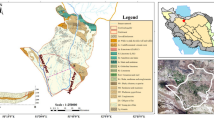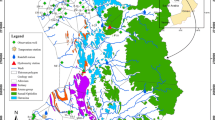Abstract
A geostatistical method was applied to optimize an existing groundwater-level monitoring network in the Upper Floridan aquifer for the South Florida Water Management District in the southeastern United States. Analyses were performed to determine suitable numbers and locations of monitoring wells that will provide equivalent or better quality groundwater-level data compared to an existing monitoring network. Ambient, unadjusted groundwater heads were expressed as salinity-adjusted heads based on the density of freshwater, well screen elevations, and temperature-dependent saline groundwater density. The optimization of the numbers and locations of monitoring wells is based on a pre-defined groundwater-level prediction error. The newly developed network combines an existing network with the addition of new wells that will result in a spatial distribution of groundwater monitoring wells that better defines the regional potentiometric surface of the Upper Floridan aquifer in the study area. The network yields groundwater-level predictions that differ significantly from those produced using the existing network. The newly designed network will reduce the mean prediction standard error by 43 % compared to the existing network. The adoption of a hexagonal grid network for the South Florida Water Management District is recommended to achieve both a uniform level of information about groundwater levels and the minimum required accuracy. It is customary to install more monitoring wells for observing groundwater levels and groundwater quality as groundwater development progresses. However, budget constraints often force water managers to implement cost-effective monitoring networks. In this regard, this study provides guidelines to water managers concerned with groundwater planning and monitoring.






Similar content being viewed by others
References
Abtew, W., Huebner, R. S., & Sunderland, S. (2002). Part I: hydrological analysis of the 2000–2001 Drought in South Florida. West Palm Beach: South Florida Water Management District.
Abtew, W., Huebner, R. S., & Pathak, C. (2007). Hydrology and hydraulics of south Florida. Proceedings, World Environmental & Water Resources Congress. May 15–19, Tampa, Florida: American Society of Civil Engineers.
Ahmadi, S. H., & Sedghamiz, A. (2007). Geostatistical analysis of spatial and temporal variations of groundwater level. Environmental Monitoring and Assessment, 129, 277–294.
Alley, W. M., & Taylor, C. J. (2001). The value of long-term ground water level monitoring. Ground Water, 39, 801.
Barca, E., Calzolari, M. C., Passarella, G., & Ungaro, F. (2013). Predicting shallow water table depth at regional scale: optimizing monitoring network in space and time. Water Resources Management, 27, 5171–5190.
Davis, J.C., & Olea, R.A. (1998). Hexagonal basis of the observation well network. In: R.D. Miller, J.C. Davis, and R.A. Olea (Eds.), 1998 Annual water level raw data report for Kansas. Open-File Report No. 98-7 (electronic version): Kansas Geological Survey.
Delbari, M., Motlagh, M. B., & Amiri, M. (2013). Spatio-temporal variability of groundwater depth in the Eghlid aquifer in southern Iran. Earth Sciences Research Journal, 17, 105–114.
Goovaerts, P. (1997). Geostatistics for natural resources evaluation. New York: Oxford University Press.
Guo, W., & Langevin, C. D. (2002). User’s guide to SEAWAT: a computer program for simulation of three-dimensional variable-density ground-water flow. Open-file report 01-434. Tallahassee: U.S. Geological Survey.
Isaaks, E., & Srivastava, R. M. (1989). An introduction to applied geostatistics. New York: Oxford University Press.
Johnston, K., Ver Hoef, J.M., Krivoruchko, K., & Lucas, N. (2001). ArcGIS 9: using ArcGIS geostatistical analyst. ESRI.
Khilali, K. (2014). Comparison of geostatistical methods for interpolation groundwater level (case study: Lake Urmia Basin). Journal of Applied Environmental and Biological Sciences, 4, 15–23.
Kitanidis, P. K. (1997). Introduction to geostatistics: application to hydrogeology. Cambridge: Cambridge University Press.
Kumar, D., & Ahmed, S. (2003). Seasonal behavior of spatial variability of groundwater level in a granitic aquifer in monsoon climate. Current Science, 84, 188–196.
Kumar, S., Sondhi, S. K., & Phogat, V. (2005). Network design for groundwater level monitoring in upper Bari Doab canal tract, Punjab, India. Irrigation and Drainage, 54, 431–442.
Lukasiewicz, J., James, C., Radin, H., Hopkins, E., Butler, D., Bengtsson, T., & Herr, J. (2002). Ground water monitor well network assessment: a district task force report. Technical memorandum WS-12. West Palm Beach: South Florida Water Management District.
McCutcheon, S. C., Martin, J. L., & Barnwell, T. O., Jr. (1993). Water quality. In D. R. Maidment (Ed.), Handbook of hydrology (pp. 11.1–11.73). New York: McGraw-Hill.
McPherson, B.F., & Halley, R. (1997). The South Florida environment: a region under stress. Circular 1134: U.S. Geological Survey.
Motz, L. H, & Bhat, S. (2012). Pilot study of groundwater-level monitoring network design for the upper Floridan aquifer. SFWMD Purchase Order 4500057295 (UF Project Number 93090), West Palm Beach, Florida: South Florida Water Management District.
Obeysekera, J., Browder, J., Hornung, L., & Harwell, M. (1999). The natural south Florida system: climate, geology, and hydrology. Urban Ecosystems, 3, 223–244.
Olea, R. A. (1984a). Sampling design optimization for spatial functions. Mathematical Geology, 16, 369–392.
Olea, R. A. (1984b). Systematic sampling of spatial functions. Series on spatial analysis no. 7. Lawrence: Kansas Geological Survey.
Olea, R., & Davis, J. (1999a). Sampling analysis and mapping of water levels in the high plains aquifer of Kansas. Open file report 1999-11. Lawrence: Kansas Geological Survey.
Olea, R., & Davis, J. (1999b). Optimizing the high plains aquifer water-level observation network. Open file report 1999-15. Lawrence: Kansas Geological Survey.
Prakash, M. R., & Singh, V. S. (2000). Network design for groundwater monitoring—a case study. Environmental Geology, 39, 628–632.
Reese, R. S., & Richardson, E. (2008). Synthesis of the hydrogeologic framework of the Floridan aquifer system and delineation of a major Avon Park permeable zone in Central and Southern Florida. Scientific Investigations Report 2007-5207: U.S. Geological Survey.
Reghunath, R., Murthy, T. R. S., & Raghavan, B. R. (2005). Time series analysis to monitor and assess water resources: a moving average approach. Environmental Monitoring and Assessment, 109, 65–72.
Rouhani, S., & Wackernagel, H. (1990). Multivariate geostatistical approach to space–time data analysis. Water Resources Research, 26, 585–591.
Shen, Y., & Wu, Y. (2013). Optimization of marine environmental monitoring sites in the Yangtze River estuary and its adjacent sea, China. Ocean and Coastal Management, 73, 92–100.
Stout, P. M. (2006). Groundwater hydrologic data strategic plan support document. Jupiter: JLA Geosciences.
Switanek, M. (1999). Ground water monitor network at the south Florida water management district. West Palm Beach: South Florida Water Management District.
Theodossiou, N., & Latinopoulos, P. (2006). Evaluation and optimization of groundwater observation networks using the Kriging methodology. Environmental Modeling and Software, 21, 991–1000.
Triki, I., Zairi, M., & Dhia, H. B. (2013). A geostatistical approach for groundwater head monitoring network optimisation: case of the Sfax superficial aquifer (Tunisia). Water and Environment Journal, 27, 362–372.
Varouchakis, E. A., & Hristopulos, D. T. (2013). Comparison of stochastic and deterministic methods for mapping groundwater level spatial variability in sparsely monitored basins. Environmental Monitoring and Assessment, 185, 1–19.
Wu, Y. (2004). Optimal design of a groundwater monitoring network in Daqing, China. Environmental Geology, 45, 527–535.
Zhou, Y., Dong, D., Liu, J., & Li, W. (2013). Upgrading a regional groundwater level monitoring network for Beijing Plain, China. Geoscience Frontiers, 4, 127–138.
Acknowledgments
The authors would like to thank Peter Kwiatkowski, Emily Richardson, Cindy Bevier, Ceyda Polatel, and Kevin Zhu with the South Florida Water Management District for their invaluable review comments and suggestions. Financial support for this project was provided by the South Florida Water Management District, West Palm Beach Florida, by means of Purchase Order 4500057295.
Author information
Authors and Affiliations
Corresponding author
Rights and permissions
About this article
Cite this article
Bhat, S., Motz, L.H., Pathak, C. et al. Geostatistics-based groundwater-level monitoring network design and its application to the Upper Floridan aquifer, USA. Environ Monit Assess 187, 4183 (2015). https://doi.org/10.1007/s10661-014-4183-x
Received:
Accepted:
Published:
DOI: https://doi.org/10.1007/s10661-014-4183-x




